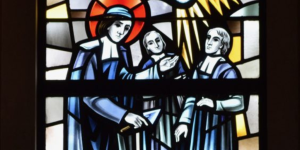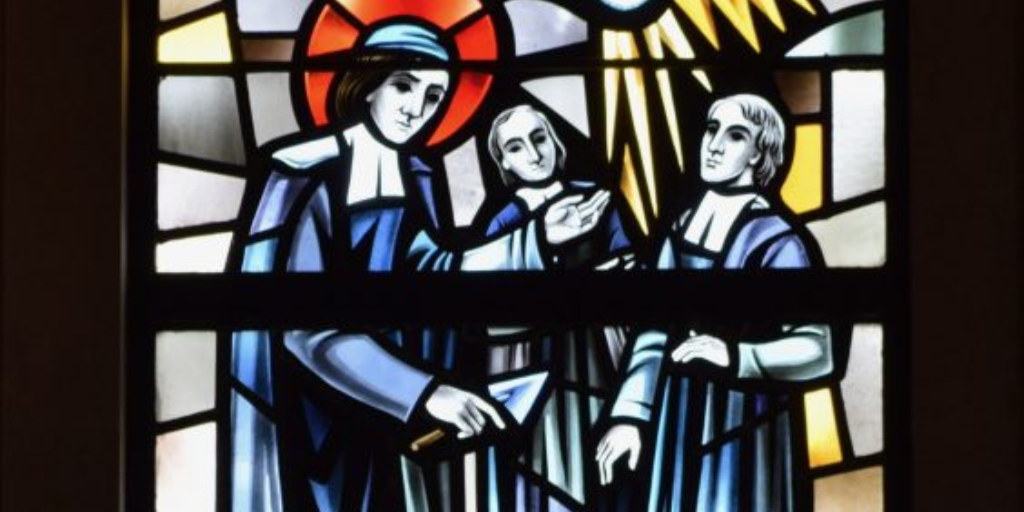
Throughout the month of April, the Church honors the lives of many saints and recognizes the impact their work and writings have had on the faith. From Saint Jean-Baptiste de La Salle and his work in France’s education system, to Saint Catherine of Siena, the first woman to be recognized as a Doctor of the Church, each of these saints have played a significant role in the growth of the Church. We invite you to read about three saints celebrated in the month of April and learn from their lives of service.
April 7 – Saint Jean-Baptiste de La Salle
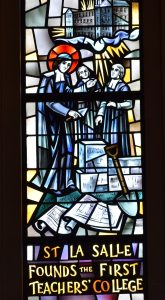
Jean-Baptiste de La Salle was the last person anyone would have expected to be a leader of educational reform – he himself was never an exceptional student. Yet his life is proof of how God works in mysterious ways and how His “power is made perfect in weakness,” (2 Corinthians 12:9). In 1679, a man named Adrien Nyel asked La Salle for help starting a school for the underprivileged in Reims, and he agreed, thinking he was simply taking on an administrative role.
The school in Reims became immensely popular, and soon, La Salle realized that additional resources would be needed, and opened his own home as a training center for teachers and a refuge for the poor. La Salle himself also taught the students and proved himself a capable educator. Unfortunately, his family never approved of his work, but that didn’t stop him from expanding his efforts and becoming wildly successful. The “Brothers of the Christian Schools” were soon known for their exceptionality. By 1717, in addition to their boy’s schools, the Brothers of the Christian Schools had established a teacher training program and an educational program for adult prisoners.
La Salle was ahead of his time in his educational methods: he would teach in vernacular languages instead of Latin, which was standard at the time; he put students in classrooms together for each subject, instead of giving individual instruction; and finally, he required silence in the classroom. The patron of teachers, Jean-Baptiste de La Salle is portrayed in the Basilica in the northeast nave clerestory window.
April 28 – Saint Louis Marie Grignion de Montfort
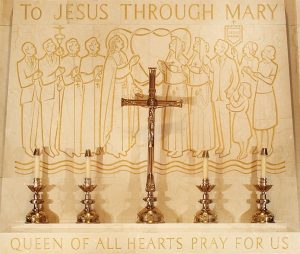
Long before the Second Vatican Council promulgated its teaching on the doctrine of the Immaculate Conception, Saint Louis Marie Grignion de Montfort, founder of the Society of Mary of Montfort, had already written on the subject. 182 years ago, Saint Louis’ work Treatise on True Devotion to the Blessed Virgin was published. Though he had written it over 100 years prior at the turn of the 18th century, it went undiscovered until 1843. It became almost immediately popular in spreading the Marian devotion.
At the heart of Louis’s work is this message: the supreme purpose of the Marian devotion is to guide the faithful to Christ. In the Catholic faith, Mary serves as an example of ultimate devotion to Christ. The Basilica honors the legacy of this “herald of Immaculate Conception” and the Marian devotion which he profoundly shaped in the Mary, Queen of All Hearts Chapel. Here, the inscription above the altar highlights that simple message: “To Jesus through Mary.”
April 29 – Saint Catherine of Siena
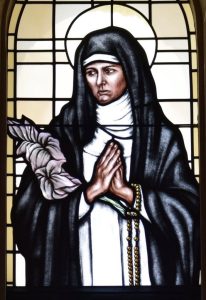
In 1347, Catherine was the 25th child born to an Italian wool-dyer and cloth merchant. When Catherine was just 15, she became a lay Dominican. Instead of entering a convent, Catherine lived a solitary lifestyle for three years, during which time she was inundated with disturbing mystical visions. But one day, they vanished – and she saw Christ instead. These visions of Christ began to happen every day, and at age 20, she decided to forsake her life of hermitage and dedicated herself to serving others.
Catherine became a champion for truth, writing her most popular books during this time, and sending letters to authority figures in the Church and government. She also became known for her diplomatic cunning, negotiating peace between armies and mediating family feuds. Catherine was bold, unafraid to call out Church leaders for letting money influence appointments and making decisions from personal and political motivations.
As she watched the Church around her continue in a pattern of spiritual decay, Catherine believed that she could carry the weight of its atonement. In her last mystical experience, she felt the Church’s weight on her back, and collapsed into a state of excruciating paralysis. Within weeks, at age 33, she died. Saint Catherine was one of the first women to be granted the title “Doctor of the Church.” She is honored in the Basilica in the Saint Catherine of Siena Chapel, as well as in the Our Lady of the Rosary Chapel and the Our Lady of Pompei Chapel.
Sources:
Butler’s Lives of Saints, ed. Bernard Bangley.
“Letter of John Paul to the Montfort Religious Family,” The Vatican.
The Way of Saints, Tom Cowan.

